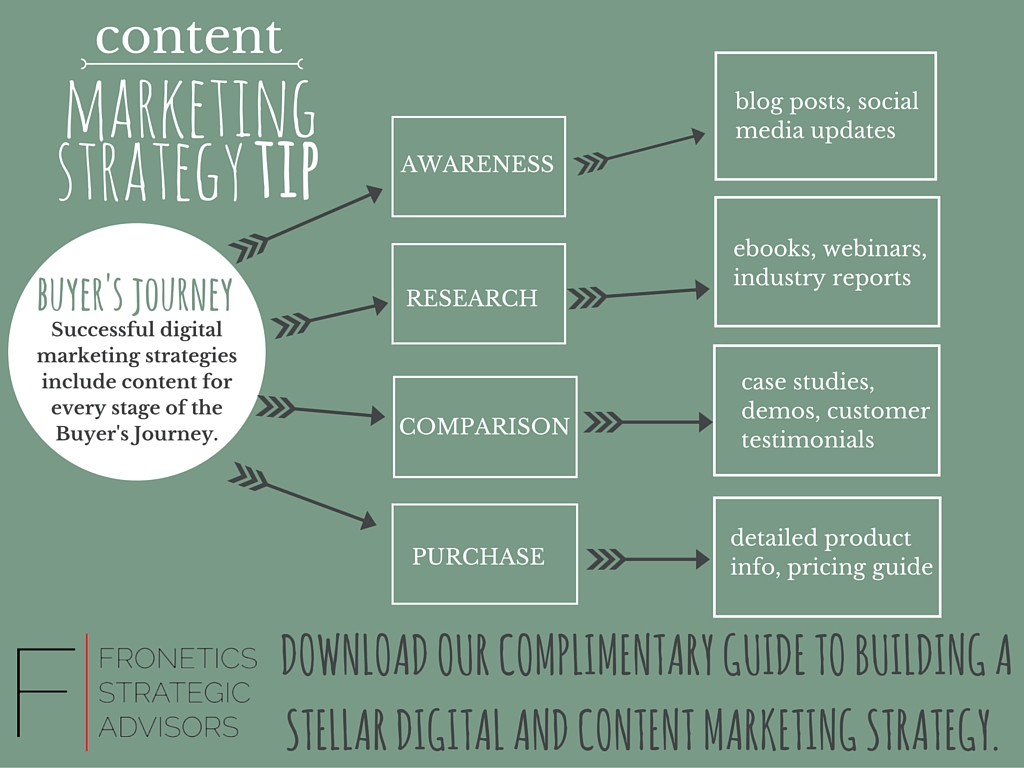
by Fronetics | Mar 9, 2016 | Blog, Content Marketing, Marketing

The other day a client called to express his frustration with content marketing. Not only was he disappointed with the number of leads that his company had obtained to date, he was also disappointed with the number of sales. He was ready to call it quits and pull the plug on all content marketing efforts.
This client was not the first to call and express frustration, nor will he be the last. Unfortunately, there is a misconception that as soon as a company incorporates a content marketing into their strategy, they will be flooded with leads — leads served on a silver platter and leads all boxed up and tied with a bow. I wish content marketing could do this — it can’t. That being said, walking away from content marketing is a big mistake — content marketing is an effective strategy that companies should employ.
The buying process for B2B buyers has become more complex and longer. The 2015 B2B Buyer’s Survey Report found that 53% of respondents reported their purchase cycle was longer than it was the previous year. The buying process has gotten longer because the majority of buyers (82%) are using more sources to research and evaluate products and services, and they are spending more time in the research phase itself. A full 80% of respondents reported they spend more time on research alone — this is up from 58% in the previous survey.
Social media and vendor-focused content are two key places where buyers turn to conduct research. More than half (53%) of survey respondents reported that social media plays in their research process, and 86% of respondents reported that content such as case studies and product data sheets influence purchase decisions.
The increased focus on research has changed when the buyers engage with a sales rep. Today, the average buyer progresses nearly 60% of the way through the purchase decision-making process before engaging with a sales rep.
Back to my client. I walked my client through these facts, and then we walked through the metrics we track on the monthly basis. Since my client had started using content marketing, traffic to his company’s website had increased significantly, visitors to the website were spending longer on it than they had before, and they were looking at more pages. Additionally the company’s social reach had grown and engagement — with customers, prospects, and others within the industry — had increased considerably. All of these things, I pointed out, were positive. I then reminded my client that the typical sales cycle for his company and industry was 12-18 months — far longer than the few short months that he had been using content marketing.
I spent the next few minutes going over the company’s content marketing strategy. We decided to make a few tweaks, and then discussed both goals and expectations going forward.
It is important for companies to recognize that content marketing should be a part of their strategy — more than ever, B2B buyers are looking for information and are using that information to make buying decisions. Companies need to be using social media. Companies need to be creating and curating quality content. It is equally important, however, for companies to realize that content marketing is not magic. Content marketing doesn’t shorten the buying process; rather it changes it. Moreover, content marketing doesn’t deliver sales — sales people still play a large role in lead nurturing and closing deals.
You may also like:
This was originally published on Electronics Purchasing Strategies.

by Fronetics | Feb 17, 2016 | Blog, Content Marketing, Manufacturing & Distribution, Marketing, Social Media, Supply Chain
 The US manufacturing index is at its lowest level since 2009. This is sobering news for the industry and for the economy. Within the industry, it is clear that the road ahead is not flat, straight, or even smooth. For companies to not just survive, but to also succeed, action needs to be taken.
The US manufacturing index is at its lowest level since 2009. This is sobering news for the industry and for the economy. Within the industry, it is clear that the road ahead is not flat, straight, or even smooth. For companies to not just survive, but to also succeed, action needs to be taken.
In August 2015 Bruce McDuffee, Principal at Knowledge Marketing for Industry, released the second edition of the Manufacturer’s Growth Manifesto. If you haven’t read this, you need to do so – today. In the Manifesto, McDuffee spells out how manufacturers can achieve growth rates of 10%, 20%, and even 30%.
The key to attaining a double digit growth rate is changing your marketing strategy and adapting to buyers’ new habits. Specifically:
- Stop pitching products and start helping people.
- Start educating your audience utilizing your particular experts and expertise for FREE.
- Stop advertising product features and benefits of a product.
- Start promoting your useful, helpful papers, webinars, seminars, videos, etc. (not product information) to foster meaningful engagement.
- Admit to yourself and your team that your products are perceived as a commodity and it will take more than product revisions, releases and enhancements to gain the attention of your target audience.
McDuffee concedes that for those who have not previously embraced and engaged in this approach to marketing, “You may be thinking, WTF?”
It may seem counterintuitive, but the results are real. Your company will be able to achieve those double digit growth rates and realize these benefits:
- Reciprocity, credibility and trust in the minds of the people in your target audience.
- Top-of-Mind Awareness (T.O.M.A.) in the minds of your prospective customers so they remember your firm first when the day comes around and they need to buy.
- Higher prices, more sales, more market share, and higher growth rates.
Success, however, depends on believing in this approach and incorporating it into your overall business strategy.
Research conducted by the Content Marketing Institute (CMI) found that while 82% of manufacturers use content marketing, only 26% say that their efforts are successful. A lack of buy-in/vision from higher ups is one of the key challenges identified by CMI. Another challenge that was reported was creating and executing a strategy; only 20% of respondents reported that they had a documented strategy. Notable though, is that 58% of the most effective companies reported that they have a documented strategy.
This approach is not relevant only to manufacturing. Companies across industries and verticals should take notice. Cerasis, a top North American third party logistics company offering logistics solutions with a strong focus on LTL freight management, shifted their marketing strategy and realized positive results. Within 25 months Cerasis realized a 14% increase in revenue. This increase was directly attributable to inbound marketing. In addition to this stream of revenue, the company’s sales team was able to generate revenue totaling $20 million during this period – more than double the previous two years combined.
Those numbers are not small potatoes. If you haven’t checked out the Manufacturer’s Growth Manifesto, make the time.
You may also like:
This was originally published on Electronics Purchasing Strategies.

by Fronetics | Jan 7, 2016 | Blog, Content Marketing, Marketing, Supply Chain

Last year was big for content marketing within the logistics and supply chain industries. While companies in general had been hesitant to adopt an inbound marketing approach, many caught on and found this strategy to have a major impact on business in 2015.
Fronetics has helped many clients achieve their goals through targeted inbound marketing efforts. Our data-driven approach aligns business objectives with a marketing program that delivers results with a targeted ROI.
Here are the top content marketing articles in 2015:
1. Five reasons companies in the supply chain and logistics industries should use inbound marketing
Though many companies within the supply chain and logistics industries tend to disregard inbound marketing, it actually can be a wildly successful strategy. Here are five reasons why companies in these industries should be using inbound marketing. Read the full article.
2. Content and Social Media: A Perfect Match for Customer Engagement and Business Growth
This guest blog by Kecia Gray, former vice president of corporate marketing & communications at Transplace, discusses how social media has become an integral part of Transplace’s marketing and communications strategy. It has been key to expanding brand awareness and the company’s thought leadership in the logistics and transportation space. Read the full article.
3. Content as a marketing tool for the logistics and supply chain industries
Fronetics Strategic Advisors conducted a survey focused on the use of content within the logistics and supply chain industries found that companies are using content as a marketing tool and are realizing results. Read the full report.
4. Report: Content use within the logistics and supply chain industries
The survey on industry content use conducted by Fronetics found that companies within the logistics and supply chain industries are creating more content than ever before. Respondents reported using content marketing in order to strengthen overall brand awareness, generate leads, and establish the company as an industry leader. Read the full report.
5. All content is not created equal. Why you need good content.
Good content drives profitable customer action, while bad content is a waste of time and precious resources. What makes good content, and how can you get it? Read the full article.
6. Get Results from Content Marketing by Telling Great Stories
Guest author Thijs Messelaar, a 15-year content-writing veteran, explains how the best content marketing is like a really good story. You must engage your audience emotionally to get them interested in you and to earn their trust. Read the full article.
7. Content marketing ROI for reverse logistics companies
Inbound marketing is effective in garnering consumers’ attention, but it is important to assess return on investment. Reverse logistics companies can use a fairly simple formula to calculate content marketing ROI. Read the full article.
8. Content marketing for the logistics and supply chain industries
Fronetics developed a content marketing guide specifically for companies within the logistics and supply chain industries. In it is step-by-step instructions, templates, lists, and samples to walk you through building your own content strategy. Read the full article.
9. Using inbound marketing to market and sell luxury real estate
Many luxury real estate firms are already using digital and social media to carry the lifestyle brand they’ve built around their properties into the online world. With the use of inbound marketing, they are creating new virtual “touch points” to connect with affluent buyers. Read the full article.
10. Six digital and content marketing tasks to outsource
Outsourcing several digital and content marketing tasks can help companies enjoy a reduction (or cost savings) in operating costs, improve their focus on core competencies, and let employees concentrate on their highest and best use. This article identifies six areas where companies can leverage outsource partners to support their digital efforts. Read full article.
If you are looking to increase business in 2016, consider contacting Fronetics to develop a content marketing strategy. We work with you to create an individualized plan for your specific situation and needs. We identify challenges, trends, and opportunities and take action so that your content marketing program constantly evolves and delivers results.
You may also like:
![How to create an effective content strategy [Template]](https://fronetics.com/wp-content/uploads/2024/10/content-strategy-1024x675.jpg)
by Fronetics | Oct 26, 2015 | Blog, Content Marketing, Marketing, Strategy
With 3 out of 4 marketers across the globe prioritizing content marketing, producing unique content to attract and convert website visitors can be tough. From social media to blog posts to ebooks and webinars, buyers are accessing your content through a myriad of channels. The amount and frequency of content to create can be dizzying. Fortunately, by starting with a solid strategy you can assure your content flows freely and your marketing content stands out.
One key element of any successful content strategy is mapping your buyer’s journey. Considering the path of purchase of current customers can give you valuable insight into the stages that a lead goes through before becoming a customer. Typically, buyers follow a track that looks something like this: awareness, research, consideration, and purchase. Knowing your buyer’s journey can inform your decisions about what kinds of content will resonate with your prospects and which channels of distribution will be most successful connecting them to your content.

Of course, just mapping out your Buyer’s Journey won’t lead to content marketing success. It’s certainly important, but it should be one component in your overall strategy. Start building a comprehensive content strategy that includes goal setting, developing buyer personas, setting keywords, and brainstorming content topics by using our free Content Strategy Template. You’ll be well on your way to creating great content and attracting even better leads.

You may also like:
Fronetics Strategic Advisors is a leading management consulting firm. Our firm works with companies to identify and execute strategies for growth and value creation.
We advise and work with companies on their most critical issues and opportunities: strategy, marketing, organization, talent acquisition, performance management, and M&A support.

by Fronetics | Aug 27, 2015 | Blog, Content Marketing, Marketing, Social Media, Strategy
 Content marketing has become a key marketing strategy for many businesses. Statistics show that content marketing generates three times more leads than traditional marketing methods – and those leads cost an average of 62% less. At Fronetics, we’ve built our content marketing services around one goal – helping our clients grow. We’re harnessing the power of content to help our clients connect and engage with leads and prospects in meaningful ways. And our clients are enjoying faster growth and higher profits because of it.
Content marketing has become a key marketing strategy for many businesses. Statistics show that content marketing generates three times more leads than traditional marketing methods – and those leads cost an average of 62% less. At Fronetics, we’ve built our content marketing services around one goal – helping our clients grow. We’re harnessing the power of content to help our clients connect and engage with leads and prospects in meaningful ways. And our clients are enjoying faster growth and higher profits because of it.
How do we use content to support our clients in their business growth?
We create quality content that helps our clients connect with leads and customers in a number of ways. First, we appeal to and engage potential customers by creating relevant content that’s aligned with the needs of our client’s target audience. Then, we nurture those leads into customers by proving the value of our clients’ products and services. Even after they become customers, we work to create positive customer experiences that make it easy for them to recommend our clients to others.
Services offerings
Here’s a quick breakdown of some the service offerings included in our comprehensive approach to content marketing:
Content strategy
Research has shown that B2B and B2C companies with a documented content strategy in place are more effective than those without one.
At Fronetics, we work with our clients to create a content strategy individualized for their specific situation and needs. We learn about our client’s business, target customers, industry, and competition. We also conduct an audit of current content and digital assets. All of this information is used to create an effective content strategy.
Content creation
There is a lot of content out there. If you want your content to stand out and drive profitable customer action you need quality content. At Fronetics, we create quality content that is keyword-optimized. Also, unlike other firms, we don’t outsource content creation. By keeping all content creation in-house we are able to ensure a quality product.
Lead generation
Once we’ve helped our clients draw visitors to their website, we work to identify potential customers and manage their leads. We create and couple high-value content like white papers and eBooks, with strategic calls-to-action that direct visitors to landing pages expertly designed to convert website visitors into leads.
Lead nurturing and customer acquisition
We work closely with our clients to develop a lead nurturing strategy to convert leads into paying customers using email and marketing automation. By segmenting leads and sending them targeted content designed to catalyze engagement, we help our clients build relationships – and importantly, trust.
Social media
Social media is an incredible tool; however, for it to be effective it must be driven by strategy, be consistent, and must have someone managing the execution. At Fronetics, our social media strategists distribute content, curate content, engage your target audience, and monitor your social networks. We develop a social media strategy that aligns with your company’s goals. We analyze your competition, classify your target audience & cultural attributes, identify the influencers in your industry, recommend platforms, detail best engagement practices, create social media schedules, and identify specific tactics that deliver results. Through the proper execution of social media, your brand is given a voice and personality, and becomes more accessible to your target audience.
Analytics and reporting
At Fronetics we take a comprehensive data driven approach to marketing. Metrics measure success, drive strategy, and demonstrate ROI. We provide our clients with monthly marketing reports.
In short, our content marketing strategies drive success for our clients. The Fronetics team is comprised of strategists, marketing professionals, writers, designers, and experts in social media. Together we leverage our experience to increase brand awareness, position our clients as thought leaders, and drive meaningful engagement with prospects and customers – all with the goal of helping our clients grow.
Get in touch with us today for a free consultation to find out if our retainer services, full or half day workshops, or a personalized service offering is right for your business. See how Fronetics can help your business grow.






![How to create an effective content strategy [Template]](https://fronetics.com/wp-content/uploads/2024/10/content-strategy-1024x675.jpg)


